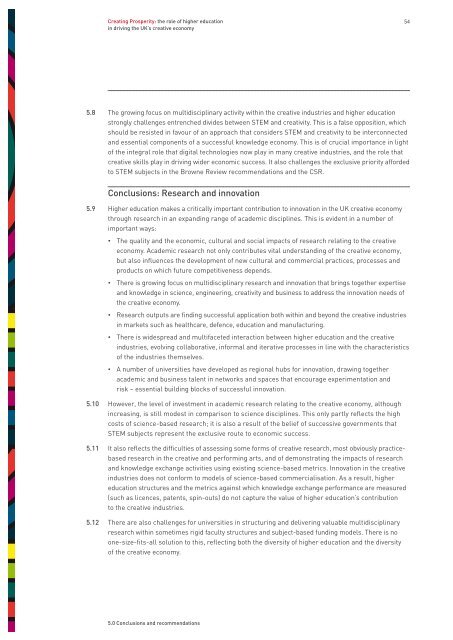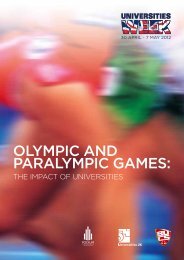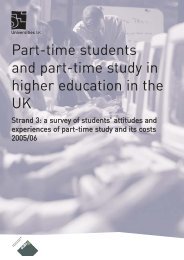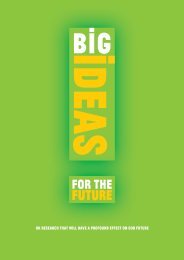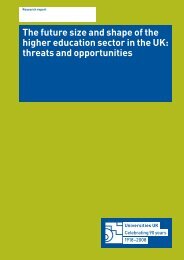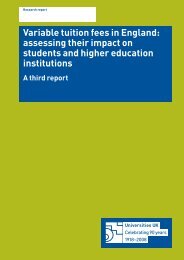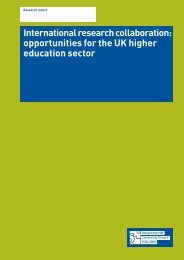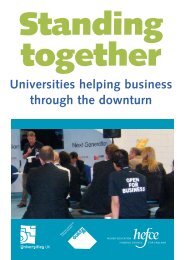Creating Prosperity: the role of higher education in ... - Universities UK
Creating Prosperity: the role of higher education in ... - Universities UK
Creating Prosperity: the role of higher education in ... - Universities UK
You also want an ePaper? Increase the reach of your titles
YUMPU automatically turns print PDFs into web optimized ePapers that Google loves.
<strong>Creat<strong>in</strong>g</strong> <strong>Prosperity</strong>: <strong>the</strong> <strong>role</strong> <strong>of</strong> <strong>higher</strong> <strong>education</strong><strong>in</strong> driv<strong>in</strong>g <strong>the</strong> <strong>UK</strong>’s creative economy545.8 The grow<strong>in</strong>g focus on multidiscipl<strong>in</strong>ary activity with<strong>in</strong> <strong>the</strong> creative <strong>in</strong>dustries and <strong>higher</strong> <strong>education</strong>strongly challenges entrenched divides between STEM and creativity. This is a false opposition, whichshould be resisted <strong>in</strong> favour <strong>of</strong> an approach that considers STEM and creativity to be <strong>in</strong>terconnectedand essential components <strong>of</strong> a successful knowledge economy. This is <strong>of</strong> crucial importance <strong>in</strong> light<strong>of</strong> <strong>the</strong> <strong>in</strong>tegral <strong>role</strong> that digital technologies now play <strong>in</strong> many creative <strong>in</strong>dustries, and <strong>the</strong> <strong>role</strong> thatcreative skills play <strong>in</strong> driv<strong>in</strong>g wider economic success. It also challenges <strong>the</strong> exclusive priority affordedto STEM subjects <strong>in</strong> <strong>the</strong> Browne Review recommendations and <strong>the</strong> CSR.Conclusions: Research and <strong>in</strong>novation5.9 Higher <strong>education</strong> makes a critically important contribution to <strong>in</strong>novation <strong>in</strong> <strong>the</strong> <strong>UK</strong> creative economythrough research <strong>in</strong> an expand<strong>in</strong>g range <strong>of</strong> academic discipl<strong>in</strong>es. This is evident <strong>in</strong> a number <strong>of</strong>important ways:• The quality and <strong>the</strong> economic, cultural and social impacts <strong>of</strong> research relat<strong>in</strong>g to <strong>the</strong> creativeeconomy. Academic research not only contributes vital understand<strong>in</strong>g <strong>of</strong> <strong>the</strong> creative economy,but also <strong>in</strong>fluences <strong>the</strong> development <strong>of</strong> new cultural and commercial practices, processes andproducts on which future competitiveness depends.• There is grow<strong>in</strong>g focus on multidiscipl<strong>in</strong>ary research and <strong>in</strong>novation that br<strong>in</strong>gs toge<strong>the</strong>r expertiseand knowledge <strong>in</strong> science, eng<strong>in</strong>eer<strong>in</strong>g, creativity and bus<strong>in</strong>ess to address <strong>the</strong> <strong>in</strong>novation needs <strong>of</strong><strong>the</strong> creative economy.• Research outputs are f<strong>in</strong>d<strong>in</strong>g successful application both with<strong>in</strong> and beyond <strong>the</strong> creative <strong>in</strong>dustries<strong>in</strong> markets such as healthcare, defence, <strong>education</strong> and manufactur<strong>in</strong>g.• There is widespread and multifaceted <strong>in</strong>teraction between <strong>higher</strong> <strong>education</strong> and <strong>the</strong> creative<strong>in</strong>dustries, evolv<strong>in</strong>g collaborative, <strong>in</strong>formal and iterative processes <strong>in</strong> l<strong>in</strong>e with <strong>the</strong> characteristics<strong>of</strong> <strong>the</strong> <strong>in</strong>dustries <strong>the</strong>mselves.• A number <strong>of</strong> universities have developed as regional hubs for <strong>in</strong>novation, draw<strong>in</strong>g toge<strong>the</strong>racademic and bus<strong>in</strong>ess talent <strong>in</strong> networks and spaces that encourage experimentation andrisk – essential build<strong>in</strong>g blocks <strong>of</strong> successful <strong>in</strong>novation.5.10 However, <strong>the</strong> level <strong>of</strong> <strong>in</strong>vestment <strong>in</strong> academic research relat<strong>in</strong>g to <strong>the</strong> creative economy, although<strong>in</strong>creas<strong>in</strong>g, is still modest <strong>in</strong> comparison to science discipl<strong>in</strong>es. This only partly reflects <strong>the</strong> highcosts <strong>of</strong> science-based research; it is also a result <strong>of</strong> <strong>the</strong> belief <strong>of</strong> successive governments thatSTEM subjects represent <strong>the</strong> exclusive route to economic success.5.11 It also reflects <strong>the</strong> difficulties <strong>of</strong> assess<strong>in</strong>g some forms <strong>of</strong> creative research, most obviously practicebasedresearch <strong>in</strong> <strong>the</strong> creative and perform<strong>in</strong>g arts, and <strong>of</strong> demonstrat<strong>in</strong>g <strong>the</strong> impacts <strong>of</strong> researchand knowledge exchange activities us<strong>in</strong>g exist<strong>in</strong>g science-based metrics. Innovation <strong>in</strong> <strong>the</strong> creative<strong>in</strong>dustries does not conform to models <strong>of</strong> science-based commercialisation. As a result, <strong>higher</strong><strong>education</strong> structures and <strong>the</strong> metrics aga<strong>in</strong>st which knowledge exchange performance are measured(such as licences, patents, sp<strong>in</strong>-outs) do not capture <strong>the</strong> value <strong>of</strong> <strong>higher</strong> <strong>education</strong>’s contributionto <strong>the</strong> creative <strong>in</strong>dustries.5.12 There are also challenges for universities <strong>in</strong> structur<strong>in</strong>g and deliver<strong>in</strong>g valuable multidiscipl<strong>in</strong>aryresearch with<strong>in</strong> sometimes rigid faculty structures and subject-based fund<strong>in</strong>g models. There is noone-size-fits-all solution to this, reflect<strong>in</strong>g both <strong>the</strong> diversity <strong>of</strong> <strong>higher</strong> <strong>education</strong> and <strong>the</strong> diversity<strong>of</strong> <strong>the</strong> creative economy.5.0 Conclusions and recommendations


